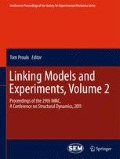Abstract
State-of-the-art technologies in computation and software have led to ever increasing size of finite element models, simply because this is possible. While it is arguable that “degree-of-freedom” proliferation is unnecessary, there are some potential benefits to be realized, namely (1) commonality of stress and dynamic models and (2) employment of finite element models in the mid- and high-frequency ranges (normally the domain of statistical energy analysis). The conventional approach to Test Analysis Model (TAM) definition for modal testing is based on Guyan Reduction. The strategy encounters severe difficulties (due to Boussinesq type singularities) when shell and 3-D elasticity elements are used to build a finite element model (FEM). This paper describes a “load-patch” variation of Guyan Reduction that alleviates 3-D problematic singularities. Two illustrative examples are used to demonstrate advantages and benefits of the new TAM definition procedure.
Preview
Unable to display preview. Download preview PDF.
References
Harris’ Shock and Vibration Handbook, 6th Ed, A. Piersol and T. Paez (Ch. 23, R. Coppolino), McGraw-Hill, 2010
The Finite Element Method: Its Basis and Fundamentals, 6th Ed, O. Zienkiewicz, R. Taylor, and J. Zhou, Elsevier,2005
"Über eine neue Methode zur Lösung gewisser Variationsprobleme der mathematischen Physik”, W. Ritz, J. reine angew. Math. 135, 1-61, 1908.
“Reduction of Stiffness and Mass Matrices”, R. Guyan, AIAA Journal, Vol. 3, 1965
“Coupling of Substructures for Dynamic Analysis”, R. Craig and M. Bampton, AIAA Journal, Vol. 6, July 1968
“Large Eigenvalue Problems in Dynamic Analysis”, K-J Bathe and E. Wilson, ASCE J. Eng. Mech. Div 98(6), 1972
The Lanczos Method Evolution and Application, L. Komzsik, Cambridge University Press, 1987
“Automated Response DOF Selection for Mapping of Experimental Normal Modes”, R. Coppolino, IMAC XVI, 1998
“A Procedure for an Improved Reduced System (IRS) Model, J. O’Callahan, IMAC VII, 1989
History of Strength of Materials, S. Timoshenko, Dover Publications, 1983
Conversations, during the mid 1980’s, with Robert T. Lahey, who had previously developed and applied a load patch procedure at Lockheed Aircraft Company.
Author information
Authors and Affiliations
Editor information
Editors and Affiliations
Rights and permissions
Copyright information
© 2011 Springer Science+Business Media, LLC
About this paper
Cite this paper
Coppolino, R.N. (2011). DOF Reduction Strategy for Large Order Finite Element Models. In: Proulx, T. (eds) Linking Models and Experiments, Volume 2. Conference Proceedings of the Society for Experimental Mechanics Series. Springer, New York, NY. https://doi.org/10.1007/978-1-4419-9305-2_25
Download citation
DOI: https://doi.org/10.1007/978-1-4419-9305-2_25
Published:
Publisher Name: Springer, New York, NY
Print ISBN: 978-1-4419-9304-5
Online ISBN: 978-1-4419-9305-2
eBook Packages: EngineeringEngineering (R0)

